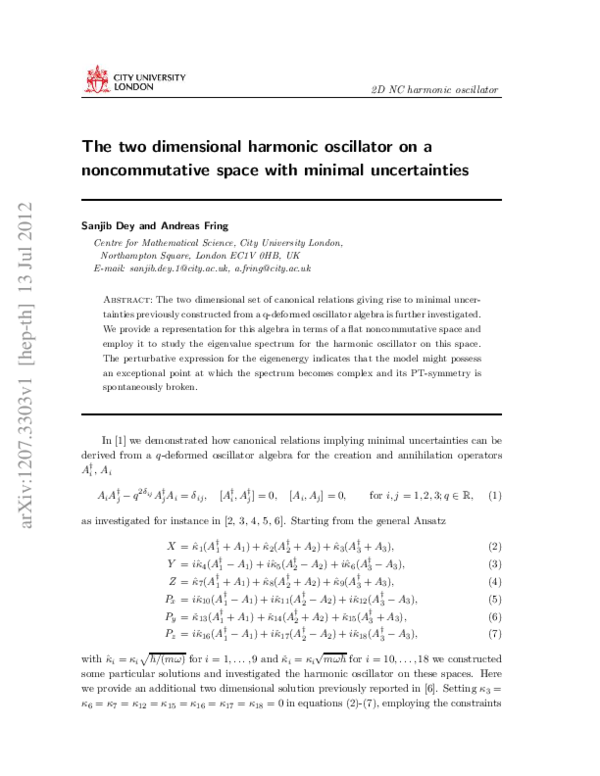Academia.edu no longer supports Internet Explorer.
To browse Academia.edu and the wider internet faster and more securely, please take a few seconds to upgrade your browser.
The Two Dimensional Harmonic . . . Noncommutative Space with Minimal Uncertainties
Related Papers
Acta Polytechnica 53 (2013) 268-276
The Two-dimensional Harmonic Oscillator on a Noncommutative Space with Minimal Uncertainties2012 •
The two dimensional set of canonical relations giving rise to minimal uncertainties previously constructed from a q-deformed oscillator algebra is further investigated. We provide a representation for this algebra in terms of a flat noncommutative space and employ it to study the eigenvalue spectrum for the harmonic oscillator on this space. The perturbative expression for the eigenenergy indicates that the model might possess an exceptional point at which the spectrum becomes complex and its PT-symmetry is spontaneously broken.
J. Phys. A: Math. Theor. 45, 385302 (2012)
PT-symmetric noncommutative spaces with minimal volume uncertainty relations2012 •
We provide a systematic procedure to relate a three dimensional q-deformed oscillator algebra to the corresponding algebra satisfied by canonical variables describing noncommutative spaces. The large number of possible free parameters in these calculations is reduced to a manageable amount by imposing various different versions of PT-symmetry on the underlying spaces, which are dictated by the specific physical problem under consideration. The representations for the corresponding operators are in general non-Hermitian with regard to standard inner products and obey algebras whose uncertainty relations lead to minimal length, areas or volumes in phase space. We analyze in particular one three dimensional solution which may be decomposed to a two dimensional noncommutative space plus one commuting space component and also into a one dimensional noncommutative space plus two commuting space components. We study some explicit models on these type of noncommutative spaces.
Journal of Physics A: Mathematical and Theoretical
$\mathcal {PT}$-symmetric non-commutative spaces with minimal volume uncertainty relations2012 •
Physical Review D
Noncommutative quantum mechanics2001 •
A general non-commutative quantum mechanical system in a central potential $V=V(r)$ in two dimensions is considered. The spectrum is bounded from below and for large values of the anticommutative parameter $\theta $, we find an explicit expression for the eigenvalues. In fact, any quantum mechanical system with these characteristics is equivalent to a commutative one in such a way that the interaction $V(r)$ is replaced by $V = V ({\hat H}_{HO}, {\hat L}_z)$, where ${\hat H}_{HO}$ is the hamiltonian of the two-dimensional harmonic oscillator and ${\hat L}_z$ is z- component of the angular momentum. For other finite values of $\theta$ the model can be solved by using perturbation theory.
2011 •
Harmonic oscillator, in 2-dimensional noncommutative phase space with non-vanishing momentum-momentum commutators, is studied using an algebraic approach. The corresponding eigenvalue problem is solved and discussed.
RELATED PAPERS
"Studia Ceranea. Journal of the Waldemar Ceran Research Centre for the History and Culture of the Mediterranean Area and South-East Europe", 13
[rec:] Dominika Gapska, Woman. Church. State. Cults of the Female Saints in the Writings of Serbian Orthodox Church, Scriptum, Cracow 2021, pp. 2082023 •
Mardella syahri
KEBIJAKAN LINGKUNGAN HIDUP DAN PEMBANGUNAN BERKELANJUTAN: STUDI KASUS PADA PENGELOLAAN HUTAN DI KOTA JAKARTA2023 •
Ιστορική Βιβλιοθήκη 1821, Εθνικό Ίδρυμα Ερευνών/ Ινστιτούτο Ιστορικών Ερευνών
Σ. Ματθαίου, Α. Χατζηδημητρίου, Οι Αρχαιότητες στα χρόνια της Επανάστασης2022 •
National Sciences of the Republic of Armenia
Իվեթ Թաջարյան և Գրետա Գասպարյան, Նոր Ջուղայի խոջայական ապարանքները որպես ճարտարապետական ժառանգության առանձնահատկությունների ուսումնասիրման աղբյուր2024 •
Proceedings 2001 IEEE International Conference on Computer Design: VLSI in Computers and Processors. ICCD 2001
Run-time execution of reconfigurable hardware in a Java environment2001 •
The European Journal of Health Economics
What reimbursement for coronary revascularization with drug-eluting stents?2004 •
Frontiers in Microbiology
Adequate Placental Sampling for the Diagnosis and Characterization of Placental Infection by Zika Virus2020 •
Energy Procedia
Density, Viscosity, Refractive Index and Heat capacity Studies of Aqueous Ethylaminoethanol Solutions at 293.15 to 323.15 K2017 •
Journal of Biological Chemistry
A Regional Net Charge and Structural Compensation Model to Explain How Negatively Charged Amino Acids Can Be Accepted within a Mitochondrial Leader Sequence1998 •
Journal of Physics B: Atomic, Molecular and Optical Physics
Multiphoton Bloch–Siegert shifts and level-splittings in spin-one systems2008 •
Bulletin of the American Astronomical Society
LiteBIRD: an all-sky cosmic microwave background probe of inflation2019 •
medRxiv (Cold Spring Harbor Laboratory)
An easy, reliable and rapid SARS-CoV2 RT-LAMP based test for Point-of-Care and diagnostic lab2020 •
Annals of Dermatology
Internalized Stigma in Pediatric Psoriasis: A Comparative Multicenter Study2020 •
- Find new research papers in:
- Physics
- Chemistry
- Biology
- Health Sciences
- Ecology
- Earth Sciences
- Cognitive Science
- Mathematics
- Computer Science

 Sanjib Dey
Sanjib Dey